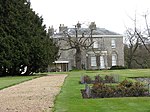Hoveton & Wroxham railway station

Hoveton & Wroxham railway station is on the Bittern Line in Norfolk, England, serving the village of Hoveton and the adjacent village of Wroxham (the two settlements are usually regarded as one). It is 8 miles 61 chains (14.1 km) down the line from Norwich and is situated between Salhouse and Worstead. It was previously the site of a junction, with the East Norfolk Railway to County School diverging from the Norwich line a short distance north of the station; however the former line closed to all traffic in 1982 and was subsequently dismantled. The station is the last on the double-track section of the Bittern line: it becomes single-track north of here to Sheringham (except for a passing loop at North Walsham and a short section into the station at Cromer). The station is managed by Greater Anglia, which also operates all passenger trains that call.
Excerpt from the Wikipedia article Hoveton & Wroxham railway station (License: CC BY-SA 3.0, Authors, Images).Hoveton & Wroxham railway station
Horning Road West, North Norfolk
Geographical coordinates (GPS) Address Nearby Places Show on map
Geographical coordinates (GPS)
| Latitude | Longitude |
|---|---|
| N 52.7154 ° | E 1.4081 ° |
Address
Horning Road West
NR12 8QJ North Norfolk
England, United Kingdom
Open on Google Maps








